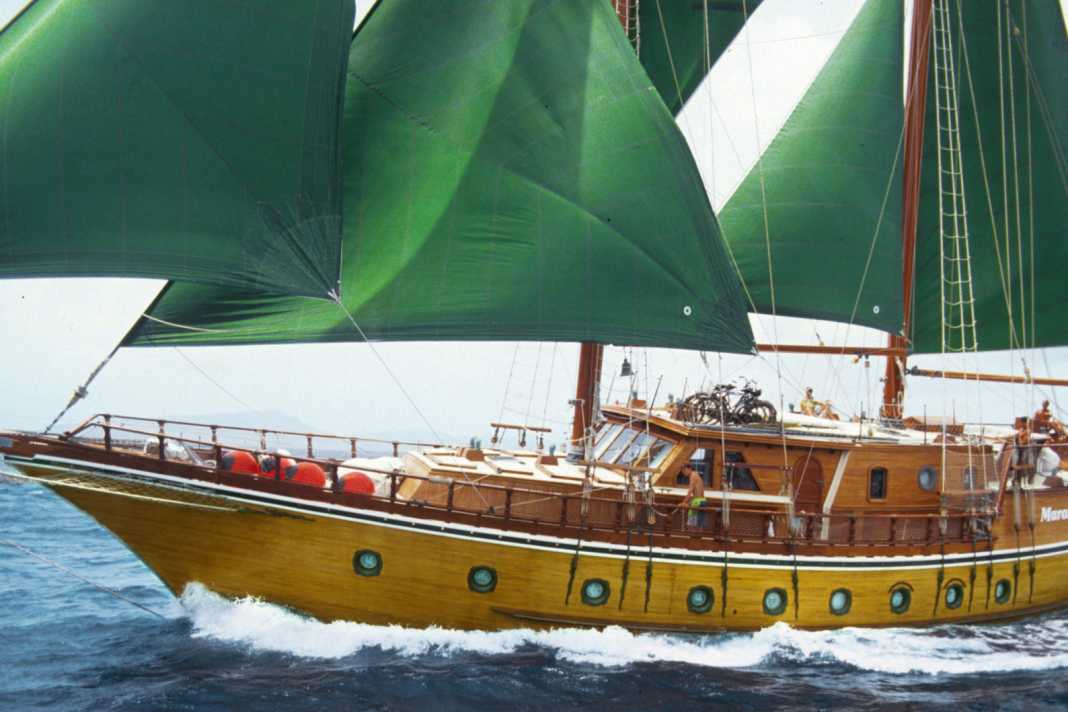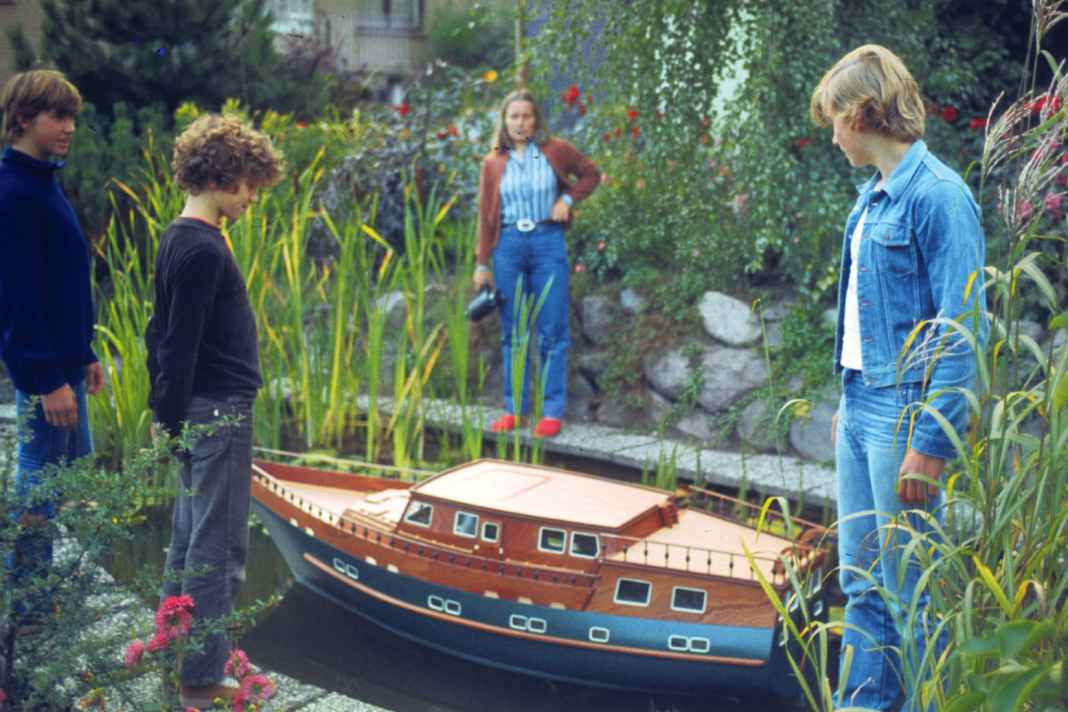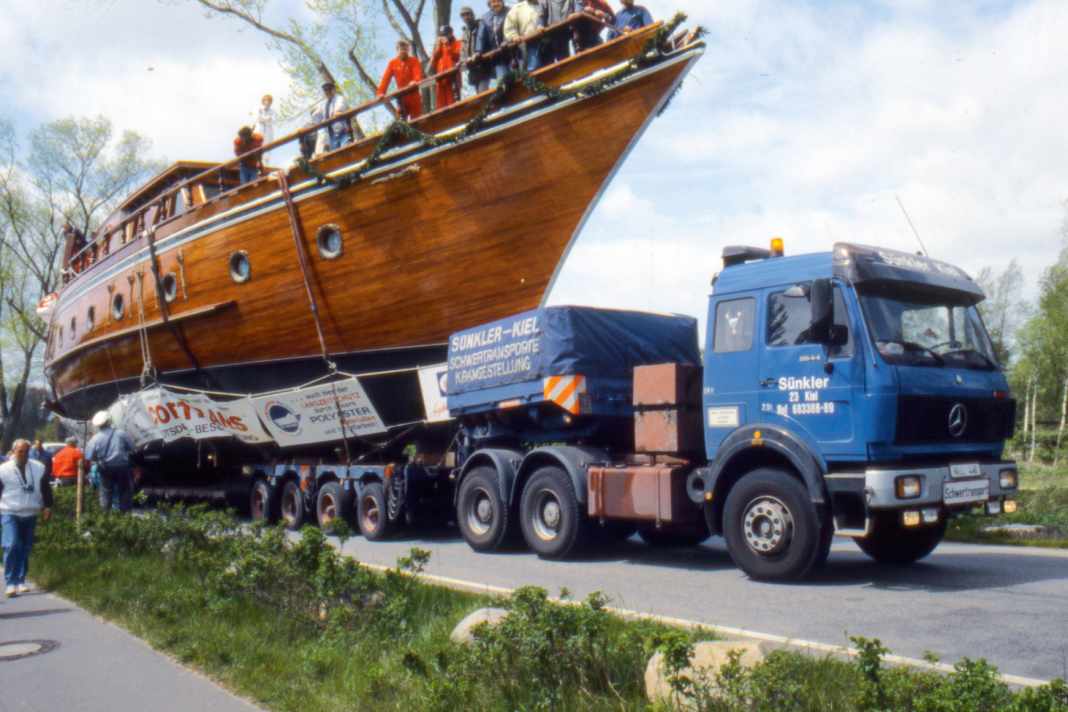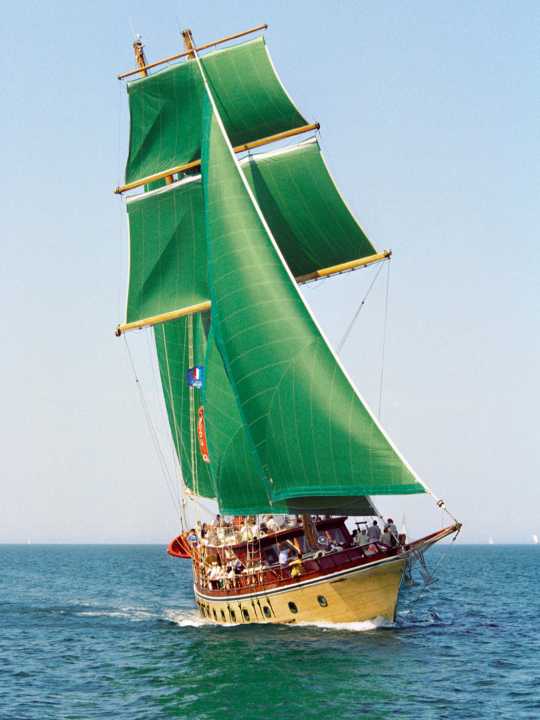




- "Maranatha" is to become a kind of vintage yacht with square rigging
- For years, everything at Grebes served only one purpose
- Brigantine becomes a place of pilgrimage
- "Maranatha" is Aramaic and means "Our Lord is coming!"
- A second life as a motor vessel on the Mediterranean
- Planning and construction
- Launching and voyage
- Technical data of the "Maranatha"
The Hanseatic city of Lübeck has many landmarks. But despite famous landmarks such as the Holsten Gate, the Buddenbrook House and the "Passat" - there was a time when sailors thought of "Lübeck" and neither the major sights nor marzipan came to mind first, but rather the "Maranatha", a rustic brigantine made of solid tropical wood, whose silhouette is reminiscent of Hanseatic cogs and pirate ships and which fitted in well with the baroque cityscape in front of which it was moored.
The construction of the ship, which was built in six years by a father and his three sons without professional help, does not follow any model. The "Maranatha" was customised exclusively to the needs of the family, who wanted to live on it while sailing around the world for several years. The ship thus became a floating superlative. The dimensions alone - the hull is 27 metres long, the overall result weighs 120 tonnes and is propelled by 600 square metres of sails - go beyond the limits of what is usual among self-builders. The 40,000 hours of labour and estimated material costs of 1.5 million marks are unimaginable for self-built ships. The fact that the "Maranatha" was nevertheless completed in 1991 and set sail on its planned voyage can only be attributed to the unbridled vigour of its long-suffering builders.
Also interesting:
The "Maranatha" was last moored in a side arm of the River Trave on the edge of Lübeck's historic city centre. The owner, endeavouring to sell her, regularly gave visitors a tour of the boat. "It's almost like being at home," says Henrik Arnold, who inherited the ship from his father, the second owner. "135 square metres of living space, seven rooms, oil central heating, fitted kitchen with dishwasher, bathrooms, washing machine."
He is right. Anyone entering the "home at sea" (YACHT 24/1992) through the huge bulkheads in the deckhouse is greeted by an interior that is more reminiscent of the interior of a 1980s terraced house than the cabin of a sailing yacht. The monstrous deckhouse houses the open galley on the starboard side, opposite the forecastle with space for ten people on a round seating area, with a steering position on each side in front. The open logbook is still on the chart table, with the last entry from 2005, since when the "Maranatha" has not undertaken any longer voyages.
"Maranatha" is to become a kind of vintage yacht with square rigging
Even the interested parties to whom Arnold has been showing the ship for years have mostly thought of using it as a houseboat, film set, floating restaurant or hotel ship. The fact that the brigantine once crossed the Atlantic in both directions, logging distances of more than 170 nautical miles and later achieving top places in tall ship regattas, was no longer of interest to anyone. The extravagant living space on and below deck, on the other hand, did, and this is what sets the "Maranatha" apart from her peers to this day. But what does "her peers" actually mean?
"There was no other type of ship like this before," states the designer and builder of the "Maranatha", Udo Grebe, in the book "Abenteuer zwischen Traum und Wirklichkeit" (Adventures between dream and reality). He wanted to create "a kind of vintage yacht with square rigging", a "pure fantasy product".
At the beginning of the 1970s, the engineer settles on the Bay of Lübeck with his wife and three sons. They spend their free time on the water. A converted 30 dinghy cruiser serves as a base, travelogues as night reading. It was the time when sailing around the world with the family became socially acceptable. And so Grebe's dream of such a voyage - and of a suitable ship for it - is born.
"It was supposed to be a real trip around the world, with the whole family, over several years, during which we wanted to get to know the country and its people," recalls Grebe's son Marius. "But there were no affordable boats on the market, either new or second-hand, that met our expectations." When his father finally sat down at the drawing board and created his own designs, his eldest son joined him with great interest.
"I really was a crazy dreamer," writes Udo Grebe. While the self-employed man's professional situation did not develop at anywhere near the same pace, the ship on paper became bigger and bigger. "Naive as I was, I first drew a 16 metre long yacht," says Grebe, who then soberly realises that the boys would probably be ready for marriage by the time they left. "So I abandoned my previous ideas and designed a 23-metre yacht."
For years, everything at Grebes served only one purpose
To outsiders, Grebe's plans seem more naive at the end than at the beginning. The enormous size of the hull made it possible to utilise two decks. Grebe thus created four spacious cabins with two bathrooms below the deckhouse. In the stern, there is space for a saloon the size of a veritable living room. The owners' spacious living area is located in the foredeck.
Grebe also sets few limits to his ideas in technical terms. He plans the four-tonne keel and the rudder blade to be hydraulically retractable. Three helm stations are planned, as well as the same building services as on land and the corresponding power supply from a generator. All the tank capacities are in line with the ideas of a large family that wants to travel self-sufficiently. They hold four tonnes of diesel, seven tonnes of fresh water and 700 litres of black water. The rig is designed to fulfil the needs of seafaring romance and yet be easy to operate, and Grebe has also found solutions for this. Two mast profiles glued from Oregon pine and two yards accommodate furling sails.
At the beginning of the eighties, everything is calculated and the design is finalised. The large family sailing boat has taken shape on paper. But there was no money to lay the keel. "It was an absurd situation," says Grebe senior himself, describing this phase of his life. "We didn't know what would happen tomorrow, but I was planning to build a sailing ship."
To overcome the situation, he and his sons built a 1:10 scale model. "We were able to operate every single sail remotely," says Marius Grebe and that the experience with the model ship, which is more than three metres long, provided important insights into the sailing characteristics. The stern was modified and the hull stretched once again to eliminate any errors that were identified.
Brigantine becomes a place of pilgrimage
In 1984, Udo Grebe sets up his own construction company and acquires a commercial property - or so he promises the banks. In fact, everything served only one purpose. As soon as the factory building was erected, Grebe and his three boys got started. On 20 December, they start building the 50 form-glued frames. It is the start of a six-year long ox tour, during which the Grebes' lives are dominated by boat building.
They soon erect the upside-down frame, which is 27 metres long, seven metres wide and three and a half metres high. The outer skin is made from five layers of mahogany using the West system of moulding. "That was tiring," says Marius Grebe, because after each layer, the huge hull has to be painstakingly sanded by hand. But even the boys have long dreamed of sailing around the world.
One day, tractors pull the finished hull out of the shed and mobile cranes help to turn the colossus over on a bed of straw bales before it disappears behind the gate again. The Grebes will be working on the extension for years to come. "Each of us built our own cabin. We also divided up the work," says Marius Grebe. Father Udo writes in detail about the difficulties in his notes. Money is a recurring theme, even though the construction company is now flourishing - the growing ship is swallowing up huge sums of money. Grebe invests an inheritance and takes out loans.
In order to build the deckhouse, the brigantine has to go outside and from then on is a place of pilgrimage for onlookers and journalists from all over northern Germany. The final spurt of work is flanked by television appearances and newspaper reports. When the ship is transported to the coast on 22 May 1991, christened and handed over to its element, thousands come to watch the spectacle.
"Maranatha" is Aramaic and means "Our Lord is coming!"
Grebes will later explain what happens on this day with their "wire to the top". Because road transport is only possible to the nearest beach, the 120-tonne ship is pushed into the water on airbags. This requires several special permits, which can only be granted in exceptional cases because dyke construction work is taking place there anyway. Whilst this sounds more like overcoming bureaucracy than providence, the storm that swept away the trees on the far too narrow avenue a few days earlier is more difficult to explain. The fact that this storm caused the lowest water level for decades and thus made the slip operation possible in the first place is also seen as a sign by more than just the Grebes. The "Maranatha" should obviously go into the water.
Even when she finally floats, public interest does not wane. While the masts, weighing several tonnes, are being erected and the ship is being fitted out, there is always a crowd of people in attendance, including the press on special days. For example, when a sponsored grand piano disappears into the stern, where it is played in the saloon by pianist Justus Franz.
It seems as if the sun has finally risen over the heavenly project after all these years of fronts when the "Maranatha" sets sail on 25 August 1991 to the delight of thousands of spectators lining the entire shore of the Trave estuary. On board was a family crew of 13. The boys are all married and the crew already includes two babies.
But the journey is not under a lucky star. The joy of setting off is overshadowed by the exhaustion that all those involved feel as a result of years of boat building and voyage preparations. Only after days of rest in Danish waters does the "Maranatha", which is still not really finished and whose sea and sailing characteristics the crew still has to familiarise itself with, reach the Skagerrak and the North Sea to head south.
But this is characterised by various imponderables. After passing Jammerbucht, the rudder breaks. It is repaired in Esbjerg, which costs time, a lot of money and insurance cover. The Bay of Biscay is only reached late in the year and is correspondingly inhospitable. Ongoing technical problems and disasters such as a fire in the engine room, damage caused by a tornado, a near-collision with a cargo ship and dangerous lee shore situations in anchor bays brought the Grebes to the brink of despair time and again. When a crew member suffers a medical emergency, an African harbour has to be called at.
A second life as a motor vessel on the Mediterranean
When the "Maranatha" finally reaches the Caribbean, the ship's coffers are empty. The hoped-for income from media reports and the book does not materialise. And after the family has explored the Caribbean intensively and some of the crew have signed off as planned, the air is out. The senior tackles what was already planned for the end of the voyage - the sale of the "Maranatha". But there is little interest. A final family voyage therefore brings the Grebes and their ship home to the Bay of Lübeck.
Here, too, the brigantine is difficult to sell, despite its high profile - until Heinz Arnold falls in love with the "Maranatha" in the early 2000s. He also had big plans and wanted to sail around the world. But this never materialised, Arnold died in 2005, and since then his son has been guiding prospective buyers through the salon where Justus Franz once took to the keys.
Now, finally, after much endeavour, he seems to have found someone. The "Maranatha" has been moored in Rostock for some time and is being refitted. The rig has already disappeared, the diesel engines are being overhauled and then it is to be given a second life as a motorised vessel on the Mediterranean.
It was a pity about the elaborately built spars, the lovingly hand-laid standing rigging and the striking green sails. Handling them had become second nature to the Grebes. As far as they know, four experienced crew members are enough to sail the square-rigged ship. And sometimes amazing things happen. From wind force 5, as Udo Grebe reports in his book, the mighty apparition reaches double-digit speeds. And, oh wonder of wonders, the "Maranatha" even steered itself.
Planning and construction






More than 20 years passed from the idea to completion. A model was the visible start of the project
Launching and voyage






After newspaper articles and television appearances, the "Maranatha" is known like the proverbial colourful dog, and not just among sailors. Thousands take part as she takes to the water
Technical data of the "Maranatha"

- Designer: Udo Grebe
- Builder: Grebe family
- Construction time: 1984-1991
- Total length: 34,00 m
- Torso length: 27,00 m
- Width: 7,00 m
- Depth: 2,00-4,00 m
- Weight: 120 t
- sail area: 600 m2
- drive (DAF diesel): 2 x 120 hp
The article first appeared in YACHT issue 05/2020 and has been revised for the online version.

